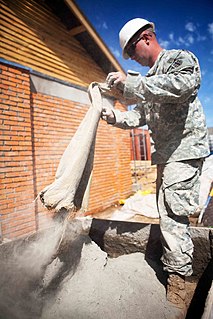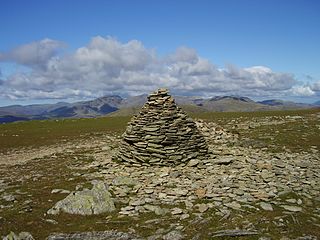
A cement is a binder, a substance used for construction that sets, hardens, and adheres to other materials to bind them together. Cement is seldom used on its own, but rather to bind sand and gravel (aggregate) together. Cement mixed with fine aggregate produces mortar for masonry, or with sand and gravel, produces concrete. Concrete is the most widely used material in existence and is behind only water as the planet's most-consumed resource.

Tuff is a type of rock made of volcanic ash ejected from a vent during a volcanic eruption. Following ejection and deposition, the ash is lithified into a solid rock. Rock that contains greater than 75% ash is considered tuff, while rock containing 25% to 75% ash is described as tuffaceous.

Caesarea Maritima, formerly Strato's Tower, also known as Caesarea Palestinae, was an ancient city in the Sharon plain on the coast of the Mediterranean, now in ruins and included in an Israeli national park.
Hydrothermal circulation in its most general sense is the circulation of hot water. Hydrothermal circulation occurs most often in the vicinity of sources of heat within the Earth's crust. In general, this occurs near volcanic activity, but can occur in the shallow to mid crust along deeply penetrating fault irregularities or in the deep crust related to the intrusion of granite, or as the result of orogeny or metamorphism.

Mortar is a workable paste which hardens to bind building blocks such as stones, bricks, and concrete masonry units, to fill and seal the irregular gaps between them, spread the weight of them evenly, and sometimes to add decorative colors or patterns to masonry walls. In its broadest sense, mortar includes pitch, asphalt, and soft mud or clay, as used between mud bricks. The word "mortar" comes from Old French mortier, "builder's mortar, plaster; bowl for mixing." (13c.).

Hydraulic mining is a form of mining that uses high-pressure jets of water to dislodge rock material or move sediment. In the placer mining of gold or tin, the resulting water-sediment slurry is directed through sluice boxes to remove the gold. It is also used in mining kaolin and coal.

Pozzolana or pozzuolana, also known as pozzolanic ash, is a natural siliceous or siliceous-aluminous material which reacts with calcium hydroxide in the presence of water at room temperature. In this reaction insoluble calcium silicate hydrate and calcium aluminate hydrate compounds are formed possessing cementitious properties. The designation pozzolana is derived from one of the primary deposits of volcanic ash used by the Romans in Italy, at Pozzuoli. The modern definition of pozzolana encompasses any volcanic material, predominantly composed of fine volcanic glass, that is used as a pozzolan. Note the difference with the term pozzolan, which exerts no bearing on the specific origin of the material, as opposed to pozzolana, which can only be used for pozzolans of volcanic origin, primarily composed of volcanic glass.

Harter Fell is a fell in the western part of the English Lake District, located between the Eskdale and Duddon valleys. Its height is 649 m (2128 ft). There are several walking routes to the summit.

The Barada is the main river of Damascus, the capital city of Syria.
Mark Howard James professionally known as The 45 King, is an American hip hop record producer and disc jockey (DJ) from The Bronx borough of New York City. James began DJing in New Jersey, in the mid-1980s. His pseudonym, the 45 King, came from his ability to make beats using obscure 45 RPM records.

Lime is a calcium-containing inorganic mineral composed primarily of oxides, and hydroxide, usually calcium oxide and/or calcium hydroxide. It is also the name for calcium oxide which occurs as a product of coal-seam fires and in altered limestone xenoliths in volcanic ejecta. The word lime originates with its earliest use as building mortar and has the sense of sticking or adhering.

Fort Rock is a tuff ring located on an ice age lake bed in north Lake County, Oregon, United States. The ring is about 4,460 feet (1,360 m) in diameter and stands about 200 feet (60 m) high above the surrounding plain. Its name is derived from the tall, straight sides that resemble the palisades of a fort. The region of Fort Rock-Christmas Lake Valley Basin contains about 40 such tuff rings and maars and is located in the Brothers Fault Zone of central Oregon's Great Basin. William Sullivan, an early settler in the area, named Fort Rock in 1873 while searching for lost cattle.
Pharpar is a biblical river in Syria. It is the less important of the two rivers of Damascus mentioned in the Book of Kings, now generally identified with the A‘waj, although if the reference to Damascus is limited to the city, as in the Arabic version of the Old Testament, Pharpar would be the modern Taura. In the early Baedeker Guides it was identified as the Al-Sabirani, a fairly downstream tributary of the A`waj. The stream runs from west to east, flowing from Hermon south of Damascus, and like its companion Abana River travels across the plain of Damascus, which owes to them much of its fertility. The river loses itself in marshes, or Lakes of the Marj, as they are called, on the borders of the great Arabian Desert.

The West Elk Mountains are a high mountain range in the west-central part of the U.S. state of Colorado. They lie primarily within the Gunnison National Forest, and part of the range is protected as the West Elk Wilderness. The range is primarily located in Gunnison County, with small parts in eastern Delta and Montrose counties.

Pozzolans are a broad class of siliceous and aluminous materials which, in themselves, possess little or no cementitious value but which will, in finely divided form and in the presence of water, react chemically with calcium hydroxide (Ca(OH)2) at ordinary temperature to form compounds possessing cementitious properties. The quantification of the capacity of a pozzolan to react with calcium hydroxide and water is given by measuring its pozzolanic activity. Pozzolana are naturally occurring pozzolans of volcanic origin.
Running beneath the Italian city of Naples and the surrounding area is an underground geothermal zone and several tunnels dug during the ages. This geothermal area is present generally from Mount Vesuvius beneath a wide area including Pompei, Herculaneum, and from the volcanic area of Campi Flegrei beneath Naples and over to Pozzuoli and the coastal Baia area. Mining and various infrastructure projects during several millennia have formed extensive caves and underground structures in the zone.

Brim Fell is a fell in the English Lake District. It stands to the west of Coniston village in the southern part of the District.

Roman concrete, also called opus caementicium, was a material used in construction in Ancient Rome. Roman concrete was based on a hydraulic-setting cement. It is durable due to its incorporation of pozzolanic ash, which prevents cracks from spreading. By the middle of the 1st century, the material was used frequently, often brick-faced, although variations in aggregate allowed different arrangements of materials. Further innovative developments in the material, called the concrete revolution, contributed to structurally complicated forms, such as the Pantheon dome, the world's largest and oldest unreinforced concrete dome.

Brisbane tuff is a type of rock, formed as a result of a volcanic eruption. As the name suggests, it is a type of tuff found in Brisbane, Queensland, Australia. It is a form of welded ignimbrite. Brisbane tuff comes in a variety of colours: pink, green, blue (grey) and purple. The different colours are due to the extent of oxidation of iron and manganese.

Fairmont Butte is a butte of volcanic origins in the Antelope Valley just west of the City of Lancaster, California in Los Angeles County. Summit elevation is 3,130 feet above sea level. Parts of Fairmont Butte are situated within the boundaries of Antelope Valley California Poppy Reserve.















